

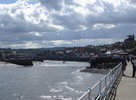 The pretty port of Whitby lies at the mouth of the River Esk, surrounded by, but not part of the national park. The town falls into three distinct parts - the well known harbour area, with its winding streets, narrow alleys and flights of steps that climb up the hillside; the abbey ruins and St. Mary's Church on the top of the cliffs east of the Esk and the beach, which runs west from the entrance of the harbour out to Sandsend.
The pretty port of Whitby lies at the mouth of the River Esk, surrounded by, but not part of the national park. The town falls into three distinct parts - the well known harbour area, with its winding streets, narrow alleys and flights of steps that climb up the hillside; the abbey ruins and St. Mary's Church on the top of the cliffs east of the Esk and the beach, which runs west from the entrance of the harbour out to Sandsend.
Whitby was once dominated by the abbey, standing on the cliff top to the east of the town. The abbey was founded by King Oswy of Northumbria in 655 to celebrate a victory in battle, with his kinswoman St. Hilda as the first abbess. The abbey is most famous as the location of the Synod of Whitby on 664, at which the Northumbrian church decided to follow the Catholic rather than the Irish version of Christianity. The abbey was also the home of the monk Caedmon, the author of the first poem in English - The Song of Creation.
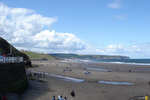 This early version of the abbey was destroyed by the Danes in 867. It was rebuilt in the eleventh century, although the current ruins date from the thirteenth and fourteenth centuries.
This early version of the abbey was destroyed by the Danes in 867. It was rebuilt in the eleventh century, although the current ruins date from the thirteenth and fourteenth centuries.
Despite its picturesque appearance a number of industries have made their impact on Whitby. The harbour was once the only safe harbour between the Tyne and the Humber, and Whitby became an important port and shipbuilding centre as well as a busy fishing port.
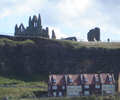 Whitby also became an important centre for whaling expeditions, after the foundation in 1753 of a whaling company in the town. By 1833 3,000 whales had been returned to Whitby, where they were rendered down for oil, producing a dreadful smell.
Whitby also became an important centre for whaling expeditions, after the foundation in 1753 of a whaling company in the town. By 1833 3,000 whales had been returned to Whitby, where they were rendered down for oil, producing a dreadful smell.
The nineteenth century saw the rise and fall of the jet trade. Jet ornaments had been created in the area in Roman and Medieval times, but the modern industry started in 1800 when John Carter and Robert Jefferson began to make jet crosses and beads in Whitby. The trade prospered, and by 1850 there were over fifty jet workshops in the town.
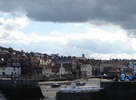 The heyday of the jet trade came after the death of Prince Albert in 1861. Queen Victoria went into strict mourning, and black jet jewellery came into fashion. By 1875 Whitby contained 200 jet workshops, which employed 1,500 men. The increased damage also led to the opening of twenty jet mines, starting at the foot of the cliffs west of Whitby and around Runswick Bay, and later spreading into the moorland dales.
The heyday of the jet trade came after the death of Prince Albert in 1861. Queen Victoria went into strict mourning, and black jet jewellery came into fashion. By 1875 Whitby contained 200 jet workshops, which employed 1,500 men. The increased damage also led to the opening of twenty jet mines, starting at the foot of the cliffs west of Whitby and around Runswick Bay, and later spreading into the moorland dales.
By the end of the nineteenth century the boom was over. Local supplies of jet ran short, and by 1892 Jet had to be imported from Spain. Fashion also changed, and the industry declined, although it still continues on a small scale.
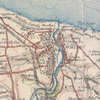 Whitby was the home of Captain Cook from 1746 until 1755. He moved to the town to serve as an apprentice to John Walker, a local ship owner and Quaker, lodging with him in the house that is now the Captain Cook Museum. Cook's first experience at sea was in flat-bottomed sailing ships known as "cats", taking the coal down the coast to London.
Whitby was the home of Captain Cook from 1746 until 1755. He moved to the town to serve as an apprentice to John Walker, a local ship owner and Quaker, lodging with him in the house that is now the Captain Cook Museum. Cook's first experience at sea was in flat-bottomed sailing ships known as "cats", taking the coal down the coast to London.
Grid Reference: NZ 89 11